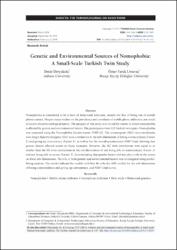| dc.contributor.author | Deryakulu, Deniz | |
| dc.contributor.author | Ursavaş, Ömer Faruk | |
| dc.date.accessioned | 2020-12-19T20:42:26Z | |
| dc.date.available | 2020-12-19T20:42:26Z | |
| dc.date.issued | 2019 | |
| dc.identifier.citation | Deryakulu, D., Ursavaş, OF. (2019). Genetic and environmental sources of nomophobia: a small-scale Turkish twin study. Addicta: The Turkish Journal on Addictions, 6(1), 147-162. | en_US |
| dc.identifier.issn | 2148-7286 | |
| dc.identifier.issn | 2149-1305 | |
| dc.identifier.uri | https://doi.org/10.15805/addicta.2019.6.1.0028 | |
| dc.identifier.uri | https://app.trdizin.gov.tr/makale/TXpVM09UQXlNZz09 | |
| dc.identifier.uri | https://hdl.handle.net/11436/5720 | |
| dc.description.abstract | Nomophobia is considered to be a form of behavioral addiction, namely the fear of being out of mobile phone contact. Despite many studies on the prevalence and correlates of mobile phone addiction, not much is known about its etiological nature. The purpose of this study is to reveal the extent to which nomophobia is affected by genetic and environmental factors. The participants were 125 Turkish twin-pairs. Nomophobia was measured using the Nomophobia Questionnaire (NMP-Q). The monozygotic (MZ) twin correlations were larger than the dizygotic (DZ) twin correlations in the sub-dimensions of losing connectedness (Factor 2) and giving up convenience (Factor 4), as well as for the overall questionnaire NMP-Total, showing that genetic factors affected scores on these measures. However, the MZ twin correlations were equal to or smaller than the DZ twin correlations in the sub-dimensions of not being able to communicate (Factor 1) and not being able to access (Factor 3), demonstrating that genetic factors did not play a role in the scores on these sub-dimensions. The role of both genetic and environmental factors was investigated using modelfitting analysis. The results indicate the models with best fit to be the ADE models for the sub-dimensions of losing connectedness and giving up convenience, and NMP-Total scores. | en_US |
| dc.language.iso | eng | en_US |
| dc.publisher | Turkish Green Crescent Soc | en_US |
| dc.rights | info:eu-repo/semantics/openAccess | en_US |
| dc.subject | Nomofobi | en_US |
| dc.subject | Cep Telefonu Bağımlılığı | en_US |
| dc.subject | Akıllı telefon Bağımlılığı | en_US |
| dc.subject | İkiz Çalışma | en_US |
| dc.subject | Davranışsal Genetik | en_US |
| dc.title | Genetic and environmental sources of nomophobia: a small-scale Turkish twin study | en_US |
| dc.type | article | en_US |
| dc.contributor.department | RTEÜ, Eğitim Fakültesi, Bilgisayar ve Öğretim Teknolojileri Eğitimi Bölümü | en_US |
| dc.contributor.institutionauthor | Ursavaş, Ömer Faruk | |
| dc.identifier.doi | 10.15805/addicta.2019.6.1.0028 | |
| dc.identifier.volume | 6 | en_US |
| dc.identifier.issue | 1 | en_US |
| dc.identifier.startpage | 147 | en_US |
| dc.identifier.endpage | 162 | en_US |
| dc.ri.edit | oa | en_US |
| dc.relation.journal | Addicta: The Turkish Journal on Addictions | en_US |
| dc.relation.publicationcategory | Makale - Uluslararası Hakemli Dergi - Kurum Öğretim Elemanı | en_US |


















